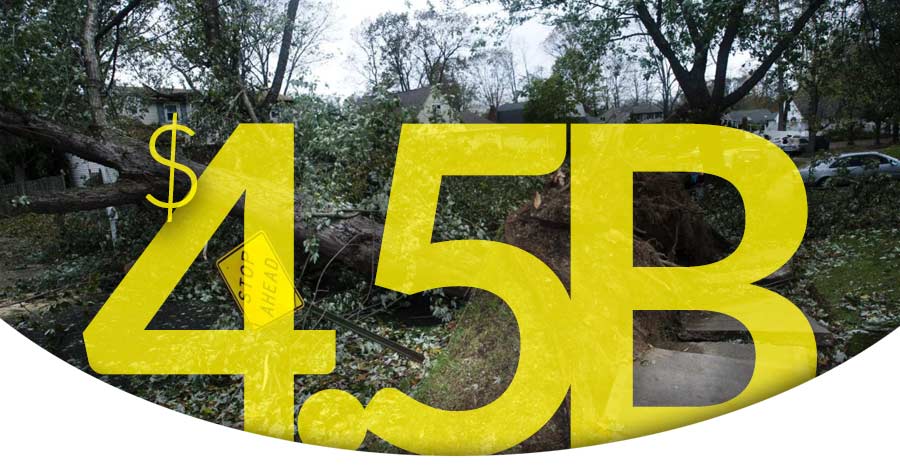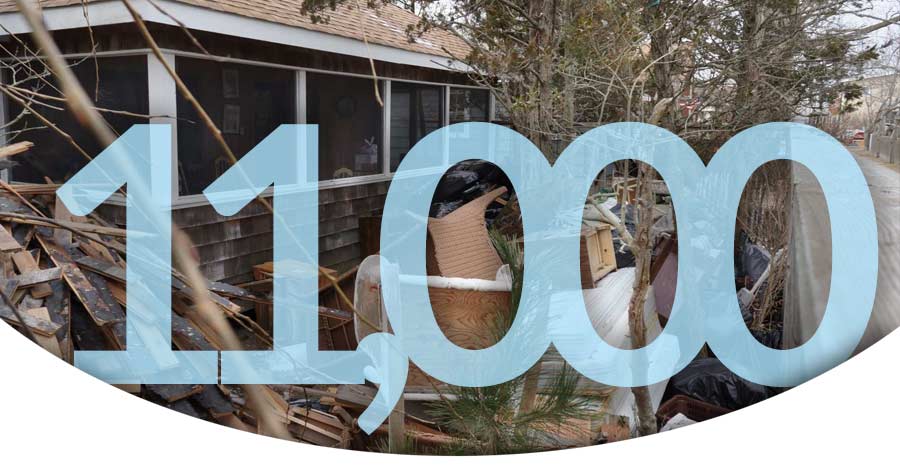10 numbers that define Superstorm Sandy
11,000 homes. 10 billion gallons. $50.5 billion.
11,000 homes. 10 billion gallons. $50.5 billion.
Five years after Sandy raged across our area, Long Islanders are only just recovering from the superstorm’s devastation. Thousands have painstakingly reconstructed and fortified their homes in fear of another great storm. Hundreds more decided not to return home at all.
This is superstorm Sandy, by the numbers:
The storm tore down power lines, destroyed waste-treatment plants and changed the geography of Fire Island. It also washed 10 billion gallons of garbage, oil and sewage into basements, onto lawns and eventually into the ocean.

Gallons of waste washed into LIers’ homes

Homes, businesses, other structures destroyed or damaged
The storm took out nearly 100,000 homes, businesses, schools, government buildings and other structures as it tore through Long Island. Of those, about 50,000 homes reported major or severe damage from Sandy.

Initial aid package for Sandy victims
The initial aid package for victims of superstorm Sandy was approved on Jan. 4, 2013, in the first legislative action of the 113th Congress. This money primarily helped the government pay initial claims submitted to the National Flood Insurance Program, which was almost out of money to compensate storm victims and required new authority to borrow to meet its obligations.

Funds in the Disaster Relief Appropriations Act of 2013
The “Sandy aid package” was a broad federal aid package for New York, New Jersey and other states struck by Sandy, as well as areas hit by Hurricane Irene and Tropical Storm Lee in 2011. Formally titled the Disaster Relief Appropriations Act of 2013, it passed the House on Jan. 15 of that year and the Senate on Jan. 27. It was signed by President Barack Obama on Jan. 29.

LI and upstate’s portion of the “Sandy aid package”
This money, administered by the Governor’s Office of Storm Recovery, included funds for homeowners through New York Rising; community reconstruction; infrastructure; economic development for businesses; and a “Rebuild by Design” effort. Nearly $2.7 billion of the total went to NY Rising. The funding also included money for victims of tropical storms Irene and Lee in 2011. The overall federal aid package included $4.2 billion for New York City, which was handled and funded separately from Long Island and other areas of New York state.

LI homes that have been elevated since Sandy
The total number of Long Island homes have been or are slated to be elevated following Sandy is nearly 3,500. They are mostly in flood zones, where raising is required to qualify for flood insurance and to rebuild in accordance with local and state building codes.

Projected cost of repairing and fortifying LI’s electrical grid
While fortification for the next storm is half finished, plans include overhauling substations and the installation of thicker utility poles that would withstand greater winds. Meanwhile, New Jersey-based PSEG took over from the Long Island Power Authority as the system operator.

LI homes in the NY Rising Housing Recovery Program
Many of these were designated as “substantially damaged” by superstorm Sandy – that is, the structure sustained damage of 50 percent or more of its pre-storm market value. For homeowners, the designation drives how much federally funded programs, such as NY Rising, contribute toward repair or rebuilding. Work has been completed on more than 7,600 of them.

Homeowners who sold to NY Rising
Hundreds of Long Islanders sold their dwellings to NY Rising through its Buyout and Acquisition Program. The agency paid $54 million for homes in the buyout program and $54 million for homes in the acquisition program.

LI homes auctioned off for restoration
Of the 500-plus storm homes sold to NY Rising, 361 were resold at auctions – 199 in Nassau County and 162 in Suffolk County – with buyers to repair and renovate them. The remaining properties, in the buyout program, were slated for demolition or conversion to other uses, such as open space or wetlands.
Sources: Federal Emergency Management Agency, Governor’s Office of Storm Recovery
Photo credits: Newsday / Jeffrey Basinger; Ed Betz; Newsday / Thomas A. Ferrara; Doug Kuntz; Barry Sloan; Newsday / Audrey C. Tiernan; Heather Walsh; Getty Images / Timothy A. Clary
